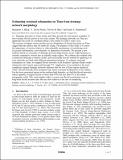Estimating erosional exhumation on Titan from drainage network morphology
Author(s)
Perron, J. Taylor; Burr, Devon M.; Drummond, Sarah A.; Black, Benjamin Alexander
DownloadPerron_Estimating erosional.pdf (1.810Mb)
PUBLISHER_POLICY
Publisher Policy
Article is made available in accordance with the publisher's policy and may be subject to US copyright law. Please refer to the publisher's site for terms of use.
Terms of use
Metadata
Show full item recordAbstract
Drainage networks on Titan, Earth, and Mars provide the only known examples of non-volcanic fluvial activity in our solar system. The drainage networks on Titan are apparently the result of a methane-ethane cycle similar to Earth's water cycle. The scarcity of impact craters and the uneven distribution of fluvial dissection on Titan suggest that the surface may be relatively young. The purpose of this study is to assess the importance of erosion relative to other plausible mechanisms of resurfacing such as tectonic deformation, cryovolcanism, or deposition of aerosols. We present a new method, based on a measure of drainage network shape known as the width function, to estimate cumulative erosion into an initially rough surface. We calibrate this method with a numerical landscape evolution model, and successfully test the method by applying it to river networks on Earth with different exhumation histories. To estimate erosional exhumation on Titan, we mapped fluvial networks in all Synthetic Aperture Radar swaths obtained by the Cassini spacecraft through T71. Application of our method to the most completely imaged drainage networks indicates that for two of four regions analyzed, Titan's fluvial networks have produced only minor erosional modification of the surface. For the best-constrained region in the northern high latitudes, we find that fluvial networks reflect spatially averaged erosion of more than 0.4% but less than 9% of the initial topographic relief. This result implies either a recent, non-fluvial resurfacing event or long-term fluvial incision rates that are slow relative to the rate of resurfacing.
Date issued
2012-08Department
Massachusetts Institute of Technology. Department of Earth, Atmospheric, and Planetary SciencesJournal
Journal of Geophysical Research
Publisher
American Geophysical Union (AGU)
Citation
Black, Benjamin A., J. Taylor Perron, Devon M. Burr, and Sarah A. Drummond. “Estimating Erosional Exhumation on Titan from Drainage Network Morphology.” Journal of Geophysical Research 117, no. E8 (2012). Copyright © 2012 American Geophysical Union
Version: Final published version
ISSN
0148-0227